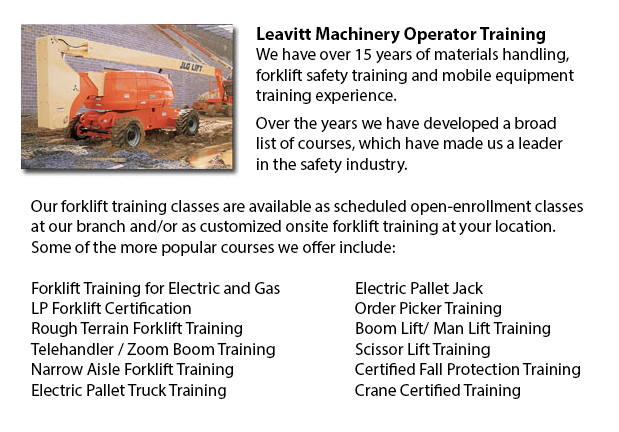
Mississauga Aerial Platform Training - Aerial forklifts are able to accommodate numerous duties involving high and tough reaching places. Sometimes used to execute daily maintenance in buildings with lofty ceilings, trim tree branches, raise burdensome shelving units or patch up telephone cables. A ladder might also be used for some of the aforementioned projects, although aerial lifts offer more security and strength when properly used.
There are a few different models of aerial lifts existing, each being capable of performing slightly different jobs. Painters will often use a scissor lift platform, which can be used to reach the 2nd story of buildings. The scissor aerial lifts use criss-cross braces to stretch out and enlarge upwards. There is a table attached to the top of the braces that rises simultaneously as the criss-cross braces raise.
Cherry pickers and bucket trucks are another variety of the aerial hoist. Usually, they contain a bucket at the end of a long arm and as the arm unfolds, the attached bucket platform rises. Platform lifts utilize a pronged arm that rises upwards as the lever is moved. Boom lifts have a hydraulic arm that extends outward and raises the platform. All of these aerial lifts require special training to operate.
Through the Occupational Safety & Health Association, also called OSHA, education programs are on hand to help ensure the employees meet occupational values for safety, system operation, inspection and repair and machine cargo capacities. Employees receive qualifications upon completion of the course and only OSHA licensed personnel should run aerial lift trucks. The Occupational Safety & Health Organization has formed guidelines to maintain safety and prevent injury while utilizing aerial lift trucks. Common sense rules such as not utilizing this apparatus to give rides and making sure all tires on aerial hoists are braced so as to prevent machine tipping are noted within the rules.
Sadly, statistics show that in excess of 20 operators die each year when running aerial lifts and 8% of those are commercial painters. The majority of these accidents are due to inappropriate tire bracing and the hoist falling over; for that reason a lot of of these deaths were preventable. Operators should make certain that all wheels are locked and braces as a critical security precaution to stop the device from toppling over.
Additional suggestions involve marking the surrounding area of the device in an obvious way to safeguard passers-by and to guarantee they do not come too close to the operating machine. It is crucial to ensure that there are also 10 feet of clearance amid any utility cables and the aerial hoist. Operators of this apparatus are also highly recommended to always have on the proper security harness when up in the air.
-
Mississauga Crane Training Courses
Mississauga Crane Training Courses - The heavy equipment crane is intended to move, lift and lower heavy stuff. Normally, the crane comes outfitted along with a hoist, sheaves, and chains or wire ropes. Cranes are utilized in the manufacturing, const... More -
Mississauga Telehandler Ticket
Mississauga Telehandler Ticket - The telescopic handler or telehandler is a normally utilized machine in agricultural and industrial applications. This machine is the same in look to a forklift and even works in a similar way, even though telehandler... More -
Mississauga Overhead Crane Ticket
Mississauga Overhead Crane Ticket - An overhead crane is normally used in industrial environments. Likewise referred to as a bridge crane, this equipment includes parallel runways spanned by a traveling bridge. The component that lifts materials is t... More -
Mississauga Forklift Safety Training
Mississauga Forklift Safety Training - Any person who wants to operate a lift truck has to take a forklift safety training program in order to become a certified forklift truck operator. There are various ways to acquire forklift training. Courses ar... More -
Mississauga Heavy Equipment Training
Mississauga Heavy Equipment Training - Normally, the different kinds of heavy equipment training are divided into 2 categories of equipment: those that have rubber tires and tracked vehicles. Tracked vehicles include items such as excavators, cranes,... More -
Mississauga Loader Ticket
Mississauga Loader Ticket - Loaders have been created to operate practically anywhere. They offer optimal traction and maneuverability because of a heavy-duty oscillating joint which offers 45-degree rotating angles toward the left and right, with 10... More -
Mississauga Boom Lift Certification
Mississauga Boom Lift Certification - Elevated work platforms allow maintenance operations and work to be done at levels which can not be reached by whichever other means. Boom Lift Certification Training educates workers about safely operating boom... More -
Mississauga Forklift Training School
Mississauga Forklift Training School - Why A Forklift Operator Must Take A Forklift Training School - Federal and industry regulators have established the criteria for forklift safety training based on their existing standards and regulations. People... More

Forklift Certification Mississauga
TOLL FREE: 1-888-254-6157
Mississauga, Ontario
forkliftcertificationmississauga.com
Email Us
About Us


